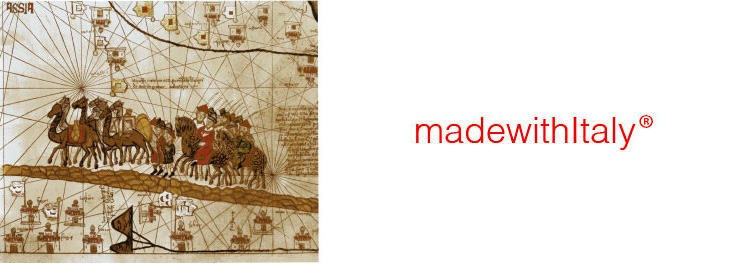


madewithItaly
®
is an innovative concept designed for Italian companies operating in foreign markets.
THE ITALIAN SCENE
Italy is a country of contradictions. In Doing Business, edited by the World Bank, it is ranked 65th out of 189 nations for the ease of doing business. The survey assesses the regulatory, procedural and bureaucratic environment in each country and its impact on the creation of new companies and the management, maintenance and development of existing ones. This ranking is behind countries such as Armenia, Rwanda, Botswana and Montenegro.
If we then filter these rankings, looking only at the 31 OECD countries with high levels of GDP, Italy is then in 29th place, followed only by Greece and the Czech Republic.
In spite of these difficulties, Italy exports a wide variety of products with only China, Germany and the United States having a superior number of exports versus imports. In addition, by adopting the trade balance as a measure of productivity, Italy is one of only five countries in the G20, along with China, Germany, Japan and Korea, to have a structural surplus when compared with other countries in the non-food manufacturing sector. Excluding energy, agricultural raw materials and mining, Italy is one of the most competitive countries in the world.
Italy is a country of contradictions. In Doing Business, edited by the World Bank, it is ranked 65th out of 189 nations for the ease of doing business. The survey assesses the regulatory, procedural and bureaucratic environment in each country and its impact on the creation of new companies and the management, maintenance and development of existing ones. This ranking is behind countries such as Armenia, Rwanda, Botswana and Montenegro.
If we then filter these rankings, looking only at the 31 OECD countries with high levels of GDP, Italy is then in 29th place, followed only by Greece and the Czech Republic.
In spite of these difficulties, Italy exports a wide variety of products with only China, Germany and the United States having a superior number of exports versus imports. In addition, by adopting the trade balance as a measure of productivity, Italy is one of only five countries in the G20, along with China, Germany, Japan and Korea, to have a structural surplus when compared with other countries in the non-food manufacturing sector. Excluding energy, agricultural raw materials and mining, Italy is one of the most competitive countries in the world.


CORPORATE CULTURE AND THE CULTURE
OF DOING BUSINESS
The crisis of recent years has significantly changed the international scene, substantially reducing the demand from traditional markets such as Europe and the United States. However, this globalization has opened up new markets, sometimes those that are unexpected. The African continent has become a market for products which are of high quality and design. Eastern, Arabic and South American countries have created opportunities for commercial development. What products can be taken into such complex markets with their cultural diversity, geographical locations, climate, religion, social policies and lifestyles? This question creates an opportunity for innovation.
The multiculturalism of the eighties onwards was seen by the Corporates as the key to accessing the world markets. The big difference now is that, whereas 30 years ago products were sourced from the Third World to sell in Milan, London and New York, today Nigeria, Brazil and India are major export markets for Europe and America. In other words, we now have to think about products that are of Italian design but inspired by the demands and expectations coming from the countries in which they are to be sold.
OF DOING BUSINESS
The crisis of recent years has significantly changed the international scene, substantially reducing the demand from traditional markets such as Europe and the United States. However, this globalization has opened up new markets, sometimes those that are unexpected. The African continent has become a market for products which are of high quality and design. Eastern, Arabic and South American countries have created opportunities for commercial development. What products can be taken into such complex markets with their cultural diversity, geographical locations, climate, religion, social policies and lifestyles? This question creates an opportunity for innovation.
The multiculturalism of the eighties onwards was seen by the Corporates as the key to accessing the world markets. The big difference now is that, whereas 30 years ago products were sourced from the Third World to sell in Milan, London and New York, today Nigeria, Brazil and India are major export markets for Europe and America. In other words, we now have to think about products that are of Italian design but inspired by the demands and expectations coming from the countries in which they are to be sold.
MULTICULTURALISM AND GLOBALIZATION:
AN OPPORTUNITY FOR INNOVATION
The crisis of recent years has significantly changed the international scene, substantially reducing the demand from traditional markets such as Europe and the United States. However, this globalization has opened up new markets, sometimes those that are unexpected. The African continent has become a market for products which are of high quality and design. Eastern, Arabic and South American countries have created opportunities for commercial development. What products can be taken into such complex markets with their cultural diversity, geographical locations, climate, religion, social policies and lifestyles? This question creates an opportunity for innovation.
The multiculturalism of the eighties onwards was seen by the Corporates as the key to accessing the world markets. The big difference now is that, whereas 30 years ago products were sourced from the Third World to sell in Milan, London and New York, today Nigeria, Brazil and India are major export markets for Europe and America. In other words, we now have to think about products that are of Italian design but inspired by the demands and expectations coming from the countries in which they are to be sold.
AN OPPORTUNITY FOR INNOVATION
The crisis of recent years has significantly changed the international scene, substantially reducing the demand from traditional markets such as Europe and the United States. However, this globalization has opened up new markets, sometimes those that are unexpected. The African continent has become a market for products which are of high quality and design. Eastern, Arabic and South American countries have created opportunities for commercial development. What products can be taken into such complex markets with their cultural diversity, geographical locations, climate, religion, social policies and lifestyles? This question creates an opportunity for innovation.
The multiculturalism of the eighties onwards was seen by the Corporates as the key to accessing the world markets. The big difference now is that, whereas 30 years ago products were sourced from the Third World to sell in Milan, London and New York, today Nigeria, Brazil and India are major export markets for Europe and America. In other words, we now have to think about products that are of Italian design but inspired by the demands and expectations coming from the countries in which they are to be sold.
madewithItaly
An edition of the Salone del Mobile 2014 confirmed that international markets have a strong interest in Italian companies and their products. However, this interest is in part a response to their existing business. This finding hints at a general disconnect between the concept stage, the manufacture of the product and the marketing and business manner in which Italian companies present themselves in foreign markets. In particular, we have identified a lack of sensitivity towards the specific needs of each different export market. Issues such as climate, religion, power supply, body care, local style and domestic rituals represent substantial variables as do the transport systems, customs and the political and social conditions.
We believe that Italian companies can increase their performance in the international markets, especially in the emerging economies outside Europe. We believe that to enable this increase a breakthrough in design and product presentation is needed to make their businesses more contemporary and international. It must begin with observing and listening to the local market requirements, so as to enable the development of products and marketing strategies that are in response to these stimuli.
The era in which the concept of Made in Italy was sold into international markets has probably completed its cycle. New strategies need to be developed to increase Italian exports.
®
_ OVERVIEWAn edition of the Salone del Mobile 2014 confirmed that international markets have a strong interest in Italian companies and their products. However, this interest is in part a response to their existing business. This finding hints at a general disconnect between the concept stage, the manufacture of the product and the marketing and business manner in which Italian companies present themselves in foreign markets. In particular, we have identified a lack of sensitivity towards the specific needs of each different export market. Issues such as climate, religion, power supply, body care, local style and domestic rituals represent substantial variables as do the transport systems, customs and the political and social conditions.
We believe that Italian companies can increase their performance in the international markets, especially in the emerging economies outside Europe. We believe that to enable this increase a breakthrough in design and product presentation is needed to make their businesses more contemporary and international. It must begin with observing and listening to the local market requirements, so as to enable the development of products and marketing strategies that are in response to these stimuli.
The era in which the concept of Made in Italy was sold into international markets has probably completed its cycle. New strategies need to be developed to increase Italian exports.
madewithItaly
As described in the introduction, madewithItaly® STUDIO MOLNI is an innovative concept in advanced marketing, aimed at making Italian companies more contemporary and commercially successful in foreign markets.
This way the products already in the catalogue will have greater commercial strength when combined with those with the new look. Through doing this the company is forced to deal with different cultures and styles, presenting some products in its portfolio in different languages therefore creating the opportunity for it to position itself effectively in the international markets.
Set in the nerve centers of the worldwide market, madewithItaly® is able to place the conceptulised products from the Italian companies with distributors and retailers in these local markets. In this way Studio Molini ensures a constant local presence offering an interface between company and customer. For some specific sectors and products madewithItaly® also deals with promoting and managing contracts and projects which in turn may provide additional opportunities for customisation at the customer's request.
®
_ STRATEGYAs described in the introduction, madewithItaly® STUDIO MOLNI is an innovative concept in advanced marketing, aimed at making Italian companies more contemporary and commercially successful in foreign markets.
Phase 1: UNDERSTANDING THE PRODUCT
Studio Molini studies the products of the Italian company in question, identifying their potential in export markets.Phase 2: IDENTIFYING FOREIGN MARKETS
Studio Molini identifies one or more foreign markets in which the Italian company in question can increase its sales or commence business if not yet present.Phase 3: RESEARCHING TRENDS
Studio Molini analyses the local trends in these foreign markets in terms of style, use of materials and finishes, diversity of the potential target markets and the budget availability.Phase 4: ADAPTING THE PRODUCT
Studio Molini takes on the job of adapting the product. Each product is specifically targeted within a geographical area. The streamlining of the producers traditional catalogue will be necessary in the event that there are overlapping products with the same target market. Catalogues containing “sets of products” customised for specific markets through Studio Molini’s easy to understand concepts can be generated. Products can be introduced using materials, finishes, colours and shapes in response to the expectations of specific markets.This way the products already in the catalogue will have greater commercial strength when combined with those with the new look. Through doing this the company is forced to deal with different cultures and styles, presenting some products in its portfolio in different languages therefore creating the opportunity for it to position itself effectively in the international markets.
Phase 5: PLACING THE CONCEPT
Studio Molini is backed by a number of international partners that support the commercial phase of madewithItaly®.Set in the nerve centers of the worldwide market, madewithItaly® is able to place the conceptulised products from the Italian companies with distributors and retailers in these local markets. In this way Studio Molini ensures a constant local presence offering an interface between company and customer. For some specific sectors and products madewithItaly® also deals with promoting and managing contracts and projects which in turn may provide additional opportunities for customisation at the customer's request.
Phase 6: PRESENTATION OF THE CONCEPT
Italian companies suffer from a historical difficulty in presenting their products in the retail outlets of their foreign distributors. Strategies and the investment in design, communications and presentation often encounter setbacks in the showrooms of the dealers. Studio Molini intends to rectify this serious problem by supporting the distributor with specific solutions for the presentation of their concepts. Traditionally Italians communicate the company's merits exclusively through the aesthetic qualities of the products, forgetting the technological component which should bring balance to the products in the international markets. Therefore, we suggest a presentation which combines the beautiful Italian design with the technological quality of its installation.
madewithItaly
The overall objective of madewithItaly® is to help Italian companies and industries to improve their rankings in international markets through creating an awareness of the opportunities missed and of those still to come. This better positioning in international markets will result in a positive return, which can be summarised as:
This strategy leads to the second positive return:
®
_ OBJECTIVESThe overall objective of madewithItaly® is to help Italian companies and industries to improve their rankings in international markets through creating an awareness of the opportunities missed and of those still to come. This better positioning in international markets will result in a positive return, which can be summarised as:
AN INCREASE IN SALES
As we mentioned, presenting some products in its portfolio in different languages can create a tremendous opportunity for the company to reposition itself and improve its international identity. The objective is to make the Italian product more attractive to specific foreign markets through customisation. This customisation can also create interest in the same product in other locations. For example, with the customization of the colours, finishes or decoration of a particular collection for the Nigerian market the same collection can be offered to the community of professionals and entrepreneurs of African origin, who live in London, Paris and New York.This strategy leads to the second positive return:



